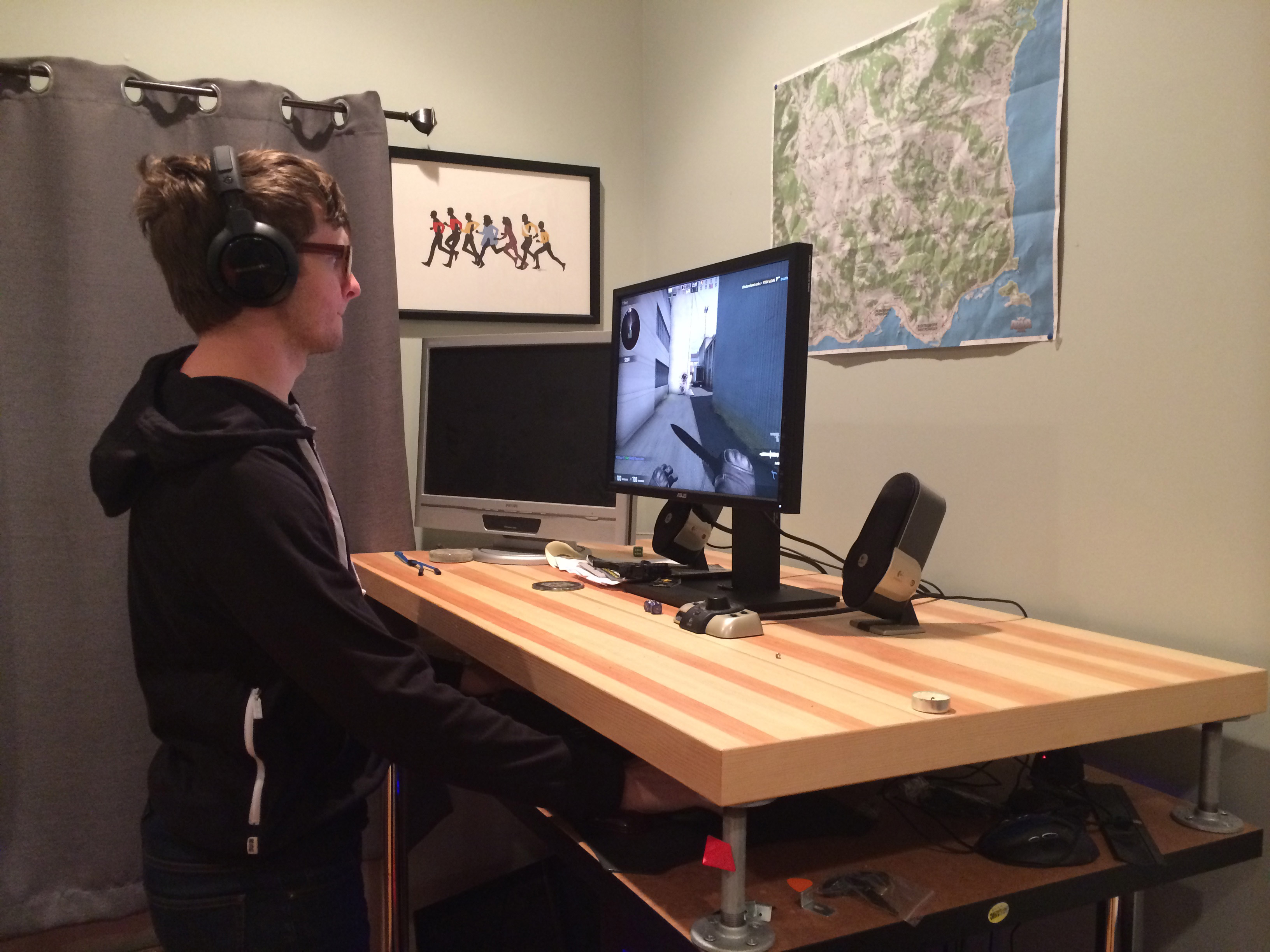A year of PC gaming with a standing desk
Here’s what I’ve learned after more than 12 months of playing PC games upright.

For the past year, almost all of the time I’ve spent playing PC games has been upright, with both feet firmly planted. When I decided to switch to a standing desk, I wasn't curious about the (“disputed,” according to Wikipedia) health benefits. I just wanted to give my gaming setup a makeover. If gaining Chun-Li legs was going to a side-effect of playing CS:GO all day, great. But I was mostly concerned with refreshing the look and feel of my desk area.
A year later, I couldn’t be happier with my setup. If I can help it, I won't play PC games in a chair at home again. Here’s what I’ve learned after more than 12 months of playing PC games upright.
Best gaming keyboard | Best gaming chairs | Best mechanical keyboard| Best wireless gaming mouse | Best wireless gaming keyboard
Do it yourself
There are a ton of pre-built standing desks available on Amazon. And almost none of them are suitable for PC gaming. Many of these desks feature questionable keyboard trays or terraced stands or, hauntingly, both. These configurations aren’t conducive to how I like to play: with a wide, spacious, fixed surface for my mouse and keyboard.
I cobbled together a standing desk from old and new IKEA parts, a variation on the “Utby Underframe” build I saw online. I used pieces of galvanized steel pipe to link two 47x24” Ikea tabletops, one of which I’d cannibalized from my old “sitting” desk. The 4” gap between them is where my peripherals sit, hiding my mouse and keyboard from the tabletop.
Because I possess zero engineering sense, I made some mistakes that required a couple days of effort and a trip to Home Depot to resolve. But I’m really happy that I built the desk myself. It’s infused my gaming space with a greater feeling of ownership, something that I think PC gaming naturally invites.
If you want a standing desk, you should build a standing desk. Like your PC itself, it’s a project that you can adapt based on how handy you are (up until that point my resume consisted of picture hanging), what your monitor configuration is, and how much money you can spend. The last thing you want is a hundred-pound block of wood off of Amazon that doesn’t suit your needs.
Keep up to date with the most important stories and the best deals, as picked by the PC Gamer team.
Side note: Ikea recently started offering a standing desk that Wired suspiciously calls affordable at $489.
Called upon my 7th grade shop class skills to make a standing desk. Curious to see how it affects gaming. pic.twitter.com/dlgPkLp3MSOctober 1, 2013
It’s uncomfortable, at first
The first two weeks of using my standing desk wasn’t the revelation in posture and personal health that I thought they’d be. Within an hour, my knees ached. My ankles got sore. I shifted my weight around a lot uncomfortably. It reminded me of Sunday afternoons spent trapped while my family wandered JCPenney.
Some of this discomfort was my own fault. I figured that the surface I had beneath my desk, some shaggy Ikea carpet, would be fine for standing. Nope. Then I tried a yoga mat—folded over itself—as a stopgap, but that barely alleviated my angry joints.
A $20 anti-fatigue mat on Amazon was what I needed. I can’t emphasize this more: if you’re running a standing desk, you need a proper mat under your feet. It isn’t optional. I’ve since completely adapted to playing while standing, to the point where I can play uninterrupted for three or four hours. (And that amount of time before I feel uncomfortable is actually something I like—read further down the page.)
My standing setup also prompted me to switch to a wireless headset. One of the things I found about a standing posture is that it naturally made me want to move around, either as minor relief from standing or, say, to jump in excitement after a victory. (Another habit I’ve gained is running into my kitchen while I’m queued for competitive CS:GO, listening in for a match to be found while I mash together some combination of bread and cheese.)
Anyway, having a cord attached to my head inhibited that; I felt tethered to the desk, and I hated it. I’ve used Steelseries’ H Wireless headset since, which has all the qualities (after audio quality) that I like in headsets: durability, breathability, comfort, a good mic, and hardware mute/volume buttons.

Evan's a hardcore FPS enthusiast who joined PC Gamer in 2008. After an era spent publishing reviews, news, and cover features, he now oversees editorial operations for PC Gamer worldwide, including setting policy, training, and editing stories written by the wider team. His most-played FPSes are CS:GO, Team Fortress 2, Team Fortress Classic, Rainbow Six Siege, and Arma 2. His first multiplayer FPS was Quake 2, played on serial LAN in his uncle's basement, the ideal conditions for instilling a lifelong fondness for fragging. Evan also leads production of the PC Gaming Show, the annual E3 showcase event dedicated to PC gaming.

